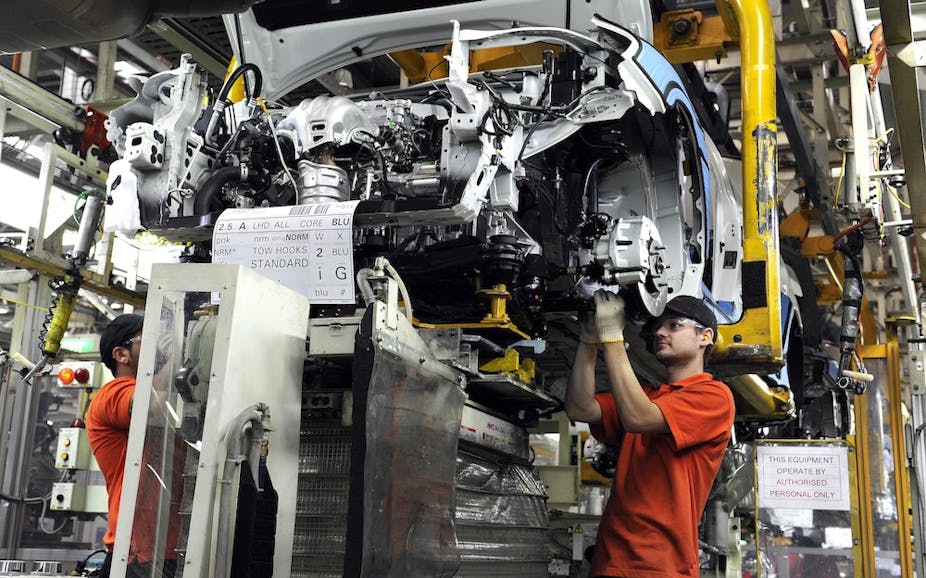Ford and Holden gone. SPC Ardmona in jeopardy. Toyota under threat.
The Productivity Commission’s (PC) position paper on automotive industry support fires a clear shot across the bows of the manufacturing industry. No industry sector can consider itself an untouchable sacred cow, strategic asset or Aussie icon.
No industry is indispensable. No firm is too big to fail.
Don’t play chicken with this Productivity Commission. Or with this federal government. Because in this game of Russian roulette, as Holden discovered, all six chambers are loaded.
Although the final report is not due until March, the future painted by the PC is stark: Toyota should receive no additional funding; the industry’s future is in doubt, given the high costs of manufacturing in Australia, compared with China and Southeast Asia; the Automotive Transformation Scheme (ATS) should not be extended beyond 2020; state and federal governments should kill the Automotive New Markets initiative after it is ramped down in 2015-16; and the Green Car Innovation Fund should be aborted following its closure, scheduled for 2014-15.
The PC further argues that the Commonwealth and state governments should abolish their purchasing policies that require them to buy cars made in Australia.
And, in a recommendation that harks back to the 1990 federal election, the PC also argues that the A$12,000 import duty on used cars should be removed. Which is one way Australian consumers can indirectly subsidise the Japanese new car industry. Or buy a bunch of used South Korean cars.
Used car imports drive more nails into the coffin of the Australian automotive components sector. Even in the absence of local car makers, some parts manufacturers would have sufficient scale to build, say, braking and suspension components for imported Mazdas, Kias, Toyotas, Nissans and Hyundais.
But not if used vehicles are imported. The volume of used parts available, while cheaper for the consumer and insurance companies, would render local manufacturing of components unviable.
To be scrupulously fair, the PC has been consistent in its approach to industry assistance for over a decade. Its 2002 car industry report sought tariff levels of 5% by 2010. The 2008 PC research report recommended the cessation of auto industry assistance by 2015. It was sceptical of the Rudd government’s proposals for increased assistance, and its economic modelling for the Bracks report was pessimistic.
From top gear to negative gearing
The PC estimates that around $30 billion (in 2011/12 dollars) in assistance has been provided to the auto industry between 1997 and 2012. That equates to around $1.875 billion per annum on average.
The Federal Chamber of Automotive Industries (FCAI) claims the Australian auto industry generated A$160 billion in turnover in 2011, or more than 10% of GDP, plus 50,000 jobs directly employed within the industry.
By contrast, as a 2013 Grattan Institute report found, property investment generates A$6 billion in rental losses annually and A$7 billion in tax breaks per annum, comprising $2.4 billion in negative gearing and A$4.5 billion in capital gains tax (CGT) exemptions. The bottom line cost to the federal budget is estimated at A$4.4 billion to 5 billion per annum.
If the Commonwealth were to be ungenerous and start asset/means testing pensions by including the family home, the Grattan report estimates that the full extent of government largesse could be as much as A$36 billion per annum.
Only 1.2 million Australians own one investment property. Only around 300,000 own three or more.
The PC argued in 2004-05 in response to the inquiry into first home ownership that negative gearing, and associated tax relief, should be reformed. The Howard government demurred. In 2011, the Gillard government dipped a cautious toe into the negative gearing reform waters, but found the temperature unbearable.
Governments always have the privilege and the luxury to afford protection, subsidies and assistance to whichever sectors they choose. As the last 14 years have shown, Commonwealth governments have rained manna from heaven on the groups that will re-elect them. Or will shower their political party with donations.
Miners, property investors, the car industry, unions, the banks and the construction industry have been major recipients of this taxpayer funded largesse. The Abbott government has demonstrated it is committed to removing manufacturing industry assistance.
But the Coalition government’s reform agenda cannot be taken seriously if it is selective about the industries it chooses to cut loose. The inequities in Australia taxation system, comprising costly, market-distorting, inefficient negative gearing and CGT exemptions, are embedded structurally within the Commonwealth budget.
If the Abbott government is serious about root-and-branch reform, it needs to consider all industry sectors that receive subsidies, tax exemptions and myriad rebates.
The car industry is a politically easy target. But Canberra is not likely to find the vested interests of the property investment class such a pushover.

